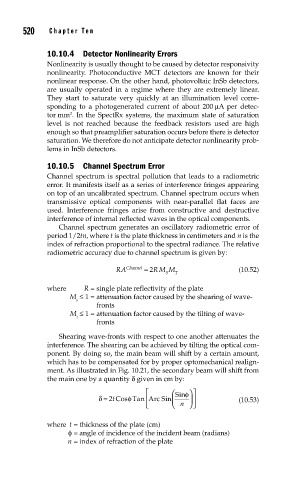Page 567 - Sensors and Control Systems in Manufacturing
P. 567
520
Cha p te r
T e n
10.10.4 Detector Nonlinearity Errors
Nonlinearity is usually thought to be caused by detector responsivity
nonlinearity. Photoconductive MCT detectors are known for their
nonlinear response. On the other hand, photovoltaic InSb detectors,
are usually operated in a regime where they are extremely linear.
They start to saturate very quickly at an illumination level corre-
sponding to a photogenerated current of about 200 μA per detec-
2
tor mm . In the SpectRx systems, the maximum state of saturation
level is not reached because the feedback resistors used are high
enough so that preamplifier saturation occurs before there is detector
saturation. We therefore do not anticipate detector nonlinearity prob-
lems in InSb detectors.
10.10.5 Channel Spectrum Error
Channel spectrum is spectral pollution that leads to a radiometric
error. It manifests itself as a series of interference fringes appearing
on top of an uncalibrated spectrum. Channel spectrum occurs when
transmissive optical components with near-parallel flat faces are
used. Interference fringes arise from constructive and destructive
interference of internal reflected waves in the optical components.
Channel spectrum generates an oscillatory radiometric error of
period 1/2tn, where t is the plate thickness in centimeters and n is the
index of refraction proportional to the spectral radiance. The relative
radiometric accuracy due to channel spectrum is given by:
RA Channel = 2 R M M (10.52)
S T
where R = single plate reflectivity of the plate
M ≤ 1 = attenuation factor caused by the shearing of wave-
s
fronts
M ≤ 1 = attenuation factor caused by the tilting of wave-
t
fronts
Shearing wave-fronts with respect to one another attenuates the
interference. The shearing can be achieved by tilting the optical com-
ponent. By doing so, the main beam will shift by a certain amount,
which has to be compensated for by proper optomechanical realign-
ment. As illustrated in Fig. 10.21, the secondary beam will shift from
the main one by a quantity δ given in cm by:
⎡ ⎛ Sin φ ⎞ ⎤
φ
⎢
δ = 2tCos Tan Arc Sin ⎜ ⎟ ⎥ (10.53)
⎣ ⎝ n ⎠ ⎦
where t = thickness of the plate (cm)
φ = angle of incidence of the incident beam (radians)
n = index of refraction of the plate

